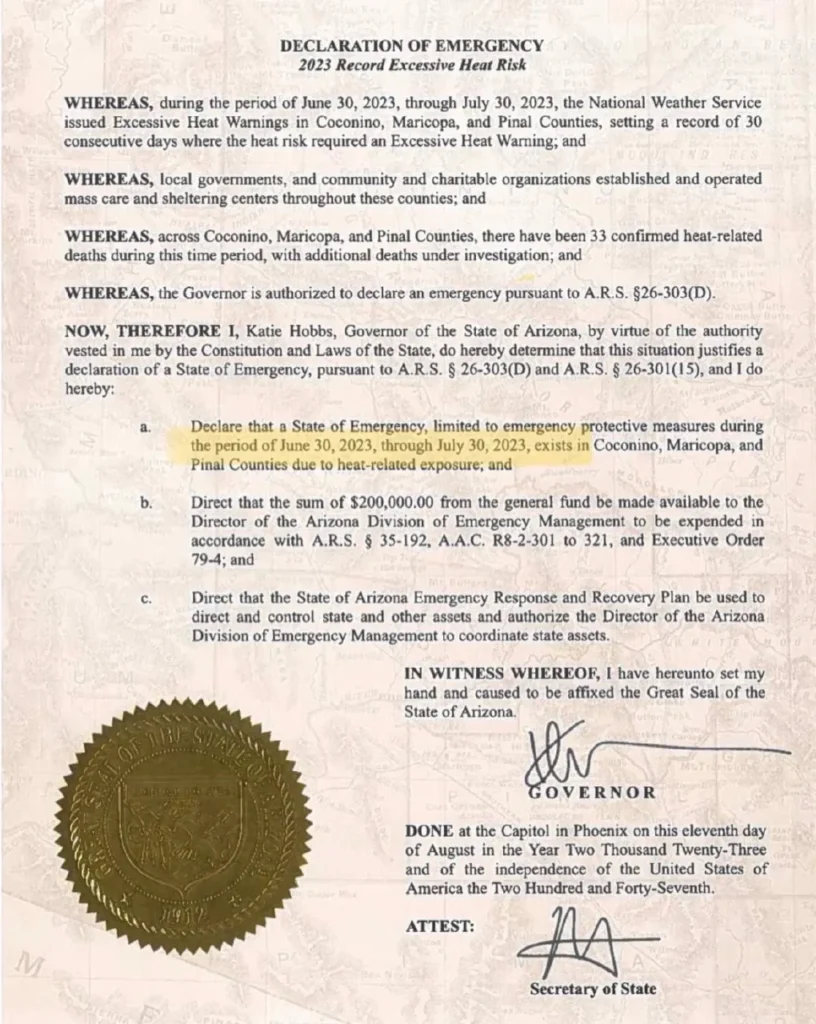Incompatible Agendas (Opinion)
Can Governor Katie Hobbs solve Housing Affordability and save Arizona with a Heat Emergency Act, or are these priorities mutually exclusive?
Affordability & Housing
According to the Arizona Governor’s website, Affordability & Housing is part of Katie’s agenda. What exactly does that mean? “Access to affordable housing is essential for building long-term prosperity.” Does this mean all Arizonans, which includes illegal immigrants? Yes. Earlier this summer, ex-GOP AZ State Senator Steve Kaiser failed three times to pass legislation effectively re-writing the rules of where Section 8 housing can be placed without public knowledge or debate. Arizona Democrats, including Katie Hobbs, want to build tax-payer subsidized Section 8 housing all over the Phoenix Metro Area. This was supposed to be the focal point for her 1st year in office and has yet to come to fruition.
Post Covid-19 saw many changes to the Phoenix Metro Area, including higher home prices and rents that have increased 15%-20%, per year, over the past 3 years and have recently seen signs of slowing. Due to high demand, buyers from out-of-state drove up the cost of Arizona’s real estate, paying 20% +/- more than the list price, as they left states where real estate is 200% more expensive.
Does a high demand for Single-Family Residential and Multi-Family Residential rentals, within the Phoenix Metropolitan Area, require state intervention to make housing affordable? Or should the market dictate what is or is not affordable to Arizona residents? Governor Hobbs believes that Federal & State Government subsidies would reduce the cost for renters and new homeowners.
Affordability & Housing revolves around high-density, multi-story housing subsidized by the U.S. Government primarily in urban areas. It comes with a cost, with hotter temperatures and less precipitation due to the amount of construction in a focused area.

Urban Heat Island
The Urban Heat Island effect is a weather phenomenon that increases the ambient temperatures of surrounding areas. High-density urban areas have higher temperatures from the Urban Heat Island effect than suburban and countryside areas. Urban areas have higher concentrations of building material, less grass and lake/water areas, and more people per square mile.
Arizona has one of the largest, and hottest, Urban Heat Islands in the world with temperatures increasing by 10 °F -15 °F degrees. Concrete, cement, and asphalt absorb the sun’s rays and retain the heat for longer periods of time. The UHI effect has been studied since the 1980s and has increased in strength over the past few decades.

Source: Roy W. Spencer, Ph. D.
HVAC
According to an ASU Study, HVAC(Heating, ventilation, & air conditioning) units increase the ambient temperature of the surrounding area, making temperatures hotter during the day, as well as the night. This further contributes to the Urban Heat Island effect that is drastically affecting the Phoenix Metropolitan Area. When you build up, adding floor after floor of units with HVACs, it concentrates the heat in a specific area.
“…climate scientists from Arizona State University are saying our air conditioning units could be making our city even hotter!”
High-density areas, with more HVAC units, only aggravate the Urban Heat Island Effect. Urbanization in the Phoenix Metro Area needs to be mitigated until technology can absorb, not deflect, the energy our cities store from the sun.
Water & the Environment – Heat Emergency 2023

On August 10, 2023, Arizona’s Governor Katie Hobbs announced she will not be seeking federal assistance, and additional tax-payer dollars, for Arizona’s Heat Emergency. The following day, a Heat Emergency Act was signed by Gov. Katie Hobbs, and it was retroactively applied from July 1st, 2023, to July 31st, 2023. She stated it was to “better coordinate future government heat response statewide and announced state-run cooling centers.”
On June 26, 1990, the high temperature for Phoenix, Arizona was 122 °F degrees. Why does Arizona need a Heat Emergency Act now if we didn’t need it 33 years ago? There has been a recent increase in heat-caused and heat-related deaths.

Source: Arizona Department of Health Services
The number of non-Arizona residents, which includes out-of-state homeless and illegal immigrants, that died due to heat-related deaths spiked after 2020. This is due to Democrat border and homeless policies that have exacerbated the situation. Non-Arizona residents account for approximately 35% of the heat deaths in Arizona and this statistic has climbed significantly in the past 3 ½ years.
Did Gov. Katie Hobbs declare a State of Emergency based on foreign nationals and homeless crossing state lines who died from heat-related causes? How many of the heat-related deaths were caused by drugs?
Current Arizona Democrat Housing & Affordability solutions will lead to hotter days and nights, due to higher density and more air conditioning units increasing the outside temperature. It will also encourage illegal immigration to Arizona, as Section-8 housing includes foreign nationals, and there has been a recent increase in non-Arizona resident deaths. This path will lead to more heat-caused and heat-related problems, so Governor Katie Hobbs can acquire more federal dollars from President Biden for her Heat Emergency Act that was recently signed.
<Opinion> Thoughts? Errors or omissions? K. Brett Boswell can be reached by email at [email protected]
K. Brett Boswell, MBA
K. Brett Boswell is an investigative reporter & C.E.O. for Page 38 News
Email: [email protected]Twitter: theBoz46 Gab: theBoz46
